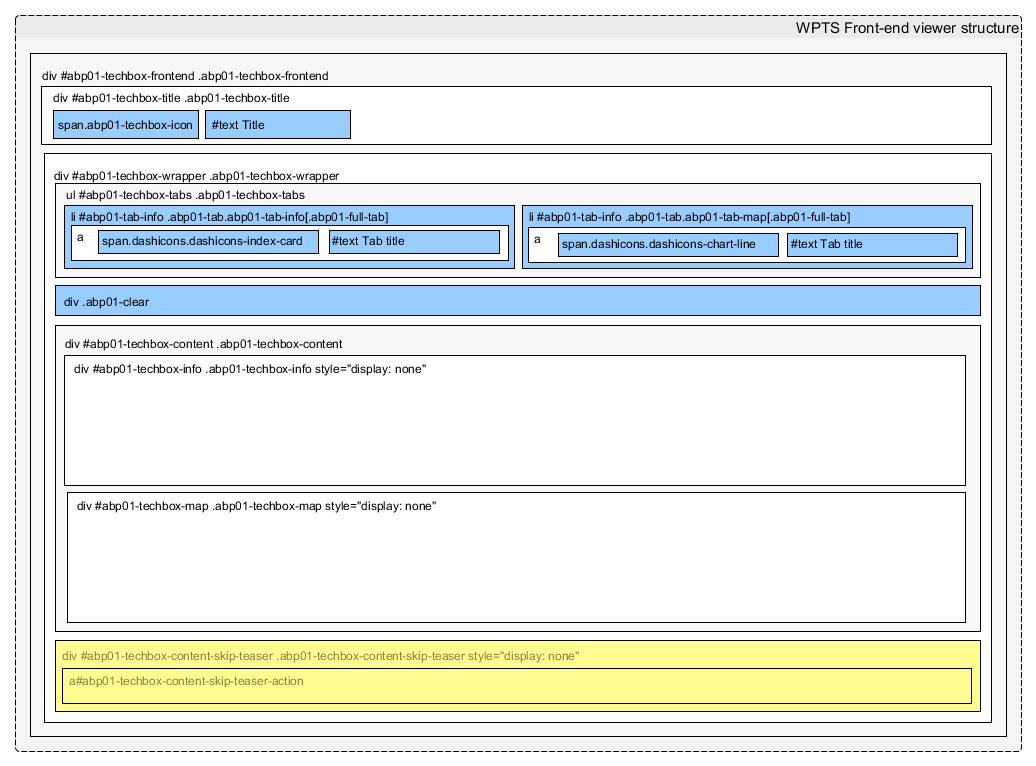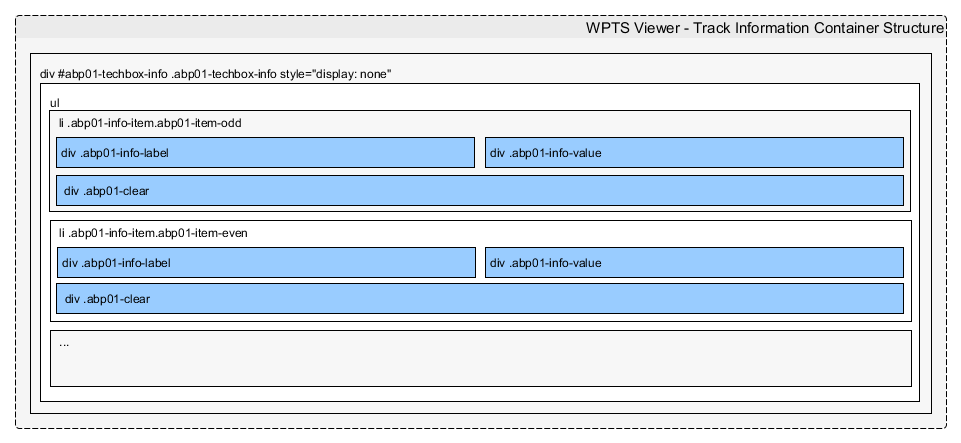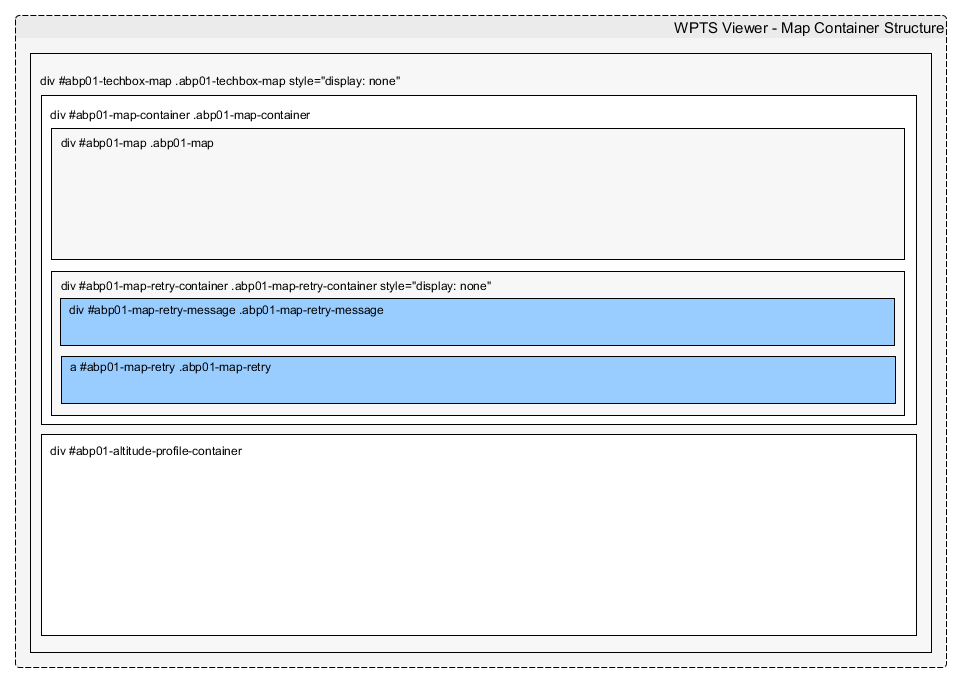-
-
Notifications
You must be signed in to change notification settings - Fork 4
Customizing the front end viewer
- Creating a new front-end viewer theme
- Integrating the front-end viewer into your own theme
- Structure of theme elements
- The front-end viewer data model
- Files that may be of interest
A front-end viewer theme describes the trip summary front-end viewer's layout and styling. There are a couple of elements that form a theme:
- the top teaser element (a small hint that's displayed on top of the post to notify the user that there's also some technical - so-to-speak - information related to the trip being described in the post);
- the viewer itself, that's either inserted at the end of the post or at a specific location using a shortcode or a block;
- the CSS styles that's applied to the above-mentioned elements;
- the JavaScript files required to add interactivity, but that's not customizable at this moment.
The customizable theme elements are formalized in an interface, Abp01_FrontendTheme (look it up over here), that defines the following methods:
-
function includeFrontendViewerStyles()- Enqueue styles to be used with the front-end viewer; -
function registerFrontendViewerHelpers()- Include the front-end viewer view helpers if needed (see below); -
function renderTeaser(stdClass $data)- Renders the trip summary front-end top teaser; -
function renderViewer(stdClass $data)- Renders the trip summary front-end viewer; -
function getVersion()- Returns the current theme version.
WP-Trip-Summary comes, out of the box, with two implementations of this interface, which you may want to look-up and use as examples:
-
Abp01_FrontendTheme_Default, which represents the core theme shipped with the plug-in; -
Abp01_FrontendTheme_Decorator, which builds uponAbp01_FrontendTheme_Defaultand looks for overrides within the currently active blog theme (see below); if none are found, it reverts to the core elements.
At a bare minimum, you need to provide a custom stylesheet and, truth be told, most of the times that's probably the only thing you'd want.
To achieve this, you need not implement the whole thing, but merely extend one of the above-mentioned classes, depending on whether you would like to allow overrides from the currently active blog theme or not.
Please see the original stylesheet, as well as the structure of the viewer elements described below for additional information.
Example:
class My_Sexy_Theme extends extends Abp01_FrontendTheme_Default {
public function __construct(Abp01_Env $env) {//required
parent::__construct($env);
}
public function registerFrontendViewerHelpers() {
//include your own view helpers (see below), if needed, before the following line;
//if there is no need to overwrite view helpers, skip overriding this method.
parent::registerFrontendViewerHelpers();
}
public function includeFrontendViewerStyles() {
//Call parent's method if you'd like to keep
//the original stylesheet and only customize some of the elements
//If not, you may remove this line
parent::includeFrontendViewerStyles();
wp_enqueue_style(/* ... whatever ... */);
}
public function getVersion() {
//not strictly required when extending Abp01_FrontendTheme_Default
//but recommended, since, otherwise,
//Abp01_FrontendTheme_Default's version will be returned.
return '0.1.0';
}
}If you would like to customize the HTML structure of some - but not all - of the elements, you may, of course, override additional methods (such as renderTeaser(), for example), but, if the entire core structure must be done await with, just implement the interface directly.
To this end, here are a couple of guidelines:
- While it's possible to change the way the elements are laid out, those elements must exist and have the same ids and classes;
- Tab navigation is implemented using
jQuery.EasyTabs, which has its own markup requirements; - WP-Trip-Summary will pass an instance of
Abp01_Envto your theme, so the constructor signature must bepublic function __construct(Abp01_Env $env); -
Abp01_Envprovides you with access to information related to the current WP and plug-in execution environment, such as:-
function getViewFilePath($viewFile)- gets the path to a specified core WP-Trip-Summary view file; -
function getViewHelpersFilePath($helperFile)- gets the path to a specified core WP-Trip-Summary view file; -
function getViewsDir()- gets the root WP-Trip-Summary core views directory; -
function getAjaxBaseUrl()- URL toadmin-ajax.php.
-
View helpers are functions used when generating the HTML output.
Currently, there are three view helper functions (check out the entire file over here):
-
function abp01_extract_value_from_frontend_data($data, $field)- Extracts a field value from the info data store ($data->info); -
function abp01_format_info_item_value($value, $suffix)- Format the given value, also adding a suffix if not empty. -
function abp01_display_info_item($data, $field, $fieldLabel, $suffix = '')- Render a track information item, given the main data store, the field, the label and an optional suffix (used over here).
Most of the times you will only need to overwrite abp01_display_info_item, especially if you're going to change the entire HTML structure of the front-end viewer.
To overwrite only some of the core view helpers, either inherit from Abp01_FrontendTheme_Default (or Abp01_FrontendTheme_Decorator) as described above or, in case of directly implementing the Abp01_FrontendTheme interface, use Abp01_Env::getViewHelpersFilePath($helpersFilePath) to obtain the path to the core view helpers file and include it:
public function registerFrontendViewerHelpers() {
//include your own view helpers file before the following line.
require_once $this->_env->getViewHelpersFilePath('controls.frontend.php');
}Besides defining your theme as described above, you need to tell WP-Trip-Summary how to use it.
To achieve this, put all your stuff together in a WP plug-in and bind to the abp01_get_frotend_theme_class hook (which is called during the execution of WP's init action hook) and return the name of your theme class. For instance, you might do this on plugins_loaded:
function my_sexy_plugin_loaded() {
add_filter('abp01_get_frotend_theme_class', function($currentThemeClass) {
return 'My_Sexy_Theme';
});
}
add_action('plugins_loaded', 'my_sexy_plugin_loaded');For theme developers, though, or for anyone that handles his/her own theme, there is a shortcut to all of the nonsense I just described. If you remember, I said something about a class Abp01_FrontendTheme_Decorator, which looks for overrides within the currently active blog theme. If no overrides are found, it reverts to the core elements.
As it turns out, this is the default theme that comes with WP Trip Summary, which means you need only abide by a certain file structure within your theme and you can get a custom front-end viewer with much less hassle:
- Create a new directory structure in your theme's root:
abp01-viewer,abp01-viewer/media/cssandabp01-viewer/helpers; - In that directory, create all the files you want to override (see table below for names);
- The data model is accessible via
$datavariable.
| File | Location |
|---|---|
| Front-end top teaser template | abp01-viewer/wpts-frontend-teaser.php |
| Front-end viewer template | abp01-viewer/wpts-frontend.php |
| Front-end viewer CSS file | abp01-viewer/media/css/abp01-frontend-main.css |
| Front-end viewer helper functions | abp01-viewer/helpers/controls.frontend.php |
The structure of the front-end top teaser is depicted in the image below. Click here for an enlarged version.

A couple of notes:
- Each element is shown with ids ID, CSS class and default inline style, if present.
The overall structure of the WP-Trip-Summary front-end viewer is depicted in the image below. Click here for an enlarged version.

A couple of notes:
- Each element is shown with ids ID, CSS class and default inline style, if present;
- If no content is available for a given tab (either track information or map), then that tab is not show;
- If only one tab is shown, then that tab also has the CSS class
.abp01-full-tab; - Each of the content containers (
#abp01-techbox-info,#abp01-techbox-map) is only shown when its corresponding tab is selected.
The structure of the track information container (#abpp01-techbox-info) is depicted in the image below. Click here for an enlarged version.

A couple of notes:
- Each element is shown with ids ID, CSS class and default inline style, if present;
- Odd list elements are decorated with the
abp01-item-oddCSS class; - Even list elements are decorated with the
abp01-item-evenCSS class.
The structure of the map container (#abpp01-techbox-map) is depicted in the image below. Click here for an enlarged version.

A couple of notes:
- Each element is shown with ids ID, CSS class and default inline style, if present;
- The actual map is loaded and rendered inside
#abp01-map; - If the map fails to load, then a retry interface is displayed (
#abp01-map-retry-container), with an error message (#abp01-map-retry-message) and a retry button (#abp01-map-retry); - The
#abp01-altitude-profile-containerelement is only present if altitude profile is enabled in plug-in settings and is used to host the altitude profile chart, when the user requests it to be shown using the corresponding map control.
When rendering front-end viewer templates, WP-Trip-Summary provides the required data using a plain stdClass object, usually available through the $data variable.
The structure of this object is described below.
These are types that describe multiple properties in the front-end viewer data model.
This is a plain stdClass object used to describe a value assigned from a pool of lookup data items. For instance, what type of bike it's recommended for a given trip.
This is herein referred to as LookupDataItem.
| Property | Type | Description |
|---|---|---|
id |
int |
ID of the lookup data item assignment |
type |
string |
Type of lookup data item assignment |
label |
string |
The displayable label of the lookup data item. This is either the translated label (if translation is available for the current language) or the default label defined for the item. |
hasTranslation |
boolean |
Whether or not a translation is available for the current language. |
| Property | Type | Description |
|---|---|---|
info |
stdClass |
Contains track information data |
info->exists |
boolean |
Whether or not track information is available |
info->isBikingTour |
boolean |
Whether or not track information is for a biking trip |
info->isHikingTour |
boolean |
Whether or not track information is for a hiking trip |
info->isTrainRideTour |
boolean |
Whether or not track information is for a train ride trip |
| Fields available for biking trips | You may consult the field definitions over here | |
info->bikeDistance |
float |
Total distance |
info->bikeTotalClimb |
float |
Total climb/total altitude gain |
info->bikeDifficultyLevel |
LookupDataItem |
The difficulty level of the trip |
info->bikeAccess |
string |
Access information towards the start point and from the end point |
info->bikeRecommendedSeasons |
LookupDataItem[] |
The recommended seasons for the trip |
info->bikePathSurfaceType |
LookupDataItem[] |
The path surface types encountered along the way |
info->bikeBikeType |
LookupDataItem[] |
What bike types are recommended for the trip |
| Fields available for hiking trips | You may consult the field definitions over here | |
info->hikingDistance |
float |
Total distance |
info->hikingTotalClimb |
float |
Total climb/total altitude gain |
info->hikingDifficultyLevel |
LookupDataItem |
The difficulty level of the trip |
info->hikingAccess |
string |
Access information towards the start point and from the end point |
info->hikingRecommendedSeasons |
LookupDataItem[] |
The recommended seasons for the trip |
info->hikingSurfaceType |
LookupDataItem[] |
The path surface types encountered along the way |
info->hikingRouteMarkers |
string |
Description of what official trail markers to follow |
| Fields available for train ride trips | You may consult the field definitions over here | |
info->trainRideDistance |
float |
Total distance |
info->trainRideChangeNumber |
int |
How many trains were changed (how many connections) |
info->trainRideGauge |
float |
Railroad line gauge |
info->trainRideOperator |
LookupDataItem[] |
What companies operated the used trains |
info->trainRideLineStatus |
LookupDataItem[] |
Statuses for various sections of the line |
info->trainRideElectrificationStatus |
LookupDataItem[] |
Electrification statuses for various sections of the line |
info->trainRideLineType |
LookupDataItem[] |
Types (simple or double railway line) for various sections of the line |
track |
stdClass |
Contains GPX track-related data |
track->exists |
boolean |
Whether or not a GPS track has been uploaded |
postId |
int |
The post ID to which the data set belongs |
ajaxUrl |
string |
Absolut URL to admin-ajax.php
|
ajaxGetTrackAction |
string |
Action name to be used with admin-ajax.php in order to retrieve detailed GPS track data |
downloadTrackAction |
string |
Action name to be used with admin-ajax.php in order to download the GPS track file |
nonceGet |
string |
Nonce value to be used with admin-ajax.php in order to retrieve detailed GPS track data |
nonceDownload |
string |
Nonce value to be used with admin-ajax.php in order to download the GPS track file |
imgBaseUrl |
string |
URL to the plug-ins image folder |
settings |
stdClass |
Contains a snapshot of all the plug-in settings |
| File | Link |
|---|---|
| Front-end top teaser template | Click here |
| Front-end viewer template | Click here |
| Front-end viewer CSS file | Click here |
| Front-end viewer helper functions | Click here |
| Front-end viewer JavaScript file | Click here |